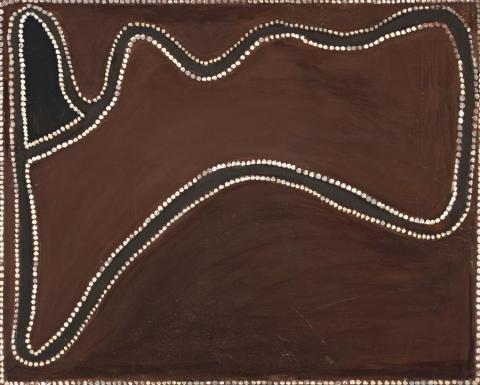SUGAR BAG HILL (ILULUNJA), c.1986
Rover Thomas (Joolama)
natural earth pigments and natural binder on plywood
80.0 x 100.0 cm
inscribed verso: artist's name, Waringarri Aboriginal Artscat. S-499 and P-575 ACJ
Waringarri Aboriginal Arts, Kununurra
Private collection, Queensland
Sotheby's, Melbourne, 9 July 2001, lot 69
Private collection, Sydney
The subject of this painting, also known as Kelly's Knob, is referred to in the second last verse of the Kurirr–Kurirr (Krill Krill) ceremony. Composed by Rover Thomas in the late 1970s, the ceremony itself was the vehicle which propelled the artist to fame firstly within the Warmun Community, and is now considered to be a cultural icon for the Miriwung and Kija people of Turkey Creek. Communicated to Thomas through a series of visions, the song cycle is centered on the spectral odyssey of the artist's classificatory mother's spirit after her passing in 1974.
As noted by Anthropologist Kim Akerman in his tribute to the artist, ‘In these dreams she transmitted to him the songs and images required to present the narrative of her journey as a shade across the Kimberley landscape. Rover was to develop the verses and teach them to others; as well as instructing and supervising the creation of a series of painted boards. Each board related to an element of the cycle and they were revealed sequentially, carried by dancers accompanied by songmen and a chorus chanting the appropriate verse... One dramatic passage refers to the spirits stopping and, from Kelly's Knob in Kununurra, looking far to the northeast to see Cyclone Tracy (itself a manifestation of the rainbow serpent), destroying the city of Darwin.'1
Accompanied by a copy of a certificate of authenticity from Waringarri Aboriginal Arts which titles the painting ‘Kelly's Knob', and states: ‘This painting shows country around Kelly's Knob, a prominent landmark in the town of Kununurra where the artist sometimes paints. The knob appears as a black dome shape at the upper left. The sinuous line that runs around the center of the painting represents the bitumen road that runs around the town of Kununurra and the irrigated farms on the Weaber plains. The artist has also shown the road running up to the knob itself to the lookout where you can see all the country that is shown in the painting. The area below the road at the bottom represents the hills beyond the plains.'
1. Akerman, K., ‘Rover Thomas', Artlink Reconciliation: Indigenous Art for the 21st Century, volume 20, number 1
MERRYN SCHRIEVER
